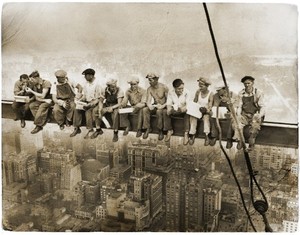Construction sites can be some of the most hopeful places, symbolizing growth, innovation, creativity, stewardship, work ethic, and resilience, attributes that we often consider to be a part of the bedrock of our societies. We look at old pictures of construction sites with nostalgia, as it reminds us of how far we have come, how we stand on the shoulders of so many who went before us, and how there are so many possibilities in this world.
We also may look at old construction site photos with a knot in our stomachs. We ask ourselves, “What were they thinking?” Just over 40 years ago, with the awareness of work-safety issues, Congress passed the Occupational Safety and Health Act of 1970, out of which the Occupational Safety and Health Administration (OSHA) was created. Since that time, the United States has increased safety measures and decreased work-site injuries and deaths by a significant margin.
We can be grateful to live in an era where it is expected that employers will consider and act upon the wellbeing and safety of their employees, and they are held responsible when those requirements are overlooked. Even so, we are still faced with unfortunate, preventable incidents on a daily basis. With that reality, we can understand that safety is not a stagnant thing that we can lay aside when we have “arrived.” It is a constant state of vigilance, awareness of surroundings, prevention, and protection.
In that light, we can take some reminders of safety from some of OSHA’s top-cited violations of construction-site safety rules, some of which may seem harmless to the casual observer, which is why it is so important to be reminded of the risks associated with them*:
-
Proper fall protection – “Each employee on a walking/working surface (horizontal and vertical surface) with an unprotected side or edge which is 6 feet or more above a lower level shall be protected from falling by the use of guardrail systems, safety net systems, or personal fall arrest systems.” [29 CFR 1926.501(b)(1)]
-
Hazard Communication Standard – “The purpose of this section is to ensure that the hazards of all chemicals produced or imported are classified, and that information concerning the classified hazards is transmitted to employers and employees.” [29 CFR 1910.1200(a)(1)]
-
Scaffolding General Requirements. [29 CFR 1926.451] “Approximately 65% of all construction workers perform work on scaffolds.” (www.constructconnect.com/blog)
-
Control of Hazardous Energy (lockout/tagout) – “This standard covers the servicing and
maintenance of machines and equipment in which the unexpected energization or start-up of the machines or equipment, or release of stored energy, could harm employees.” [29 CFR 1910.147(a)(1)(i)]
-
Stairways and Ladders. [29 CFR 1926.1053] “Improper ladder use is one of the leading causes of falls for construction workers resulting in injury or death.” (www.constructconnect.com/blog)
We are fortunate in our culture to have an overall consensus in the importance of safety and health, which is evidenced by our government’s laws and policies. At Oliver Law Firm, we endeavor to support and uphold those standards and laws, in order to promote and maintain the importance of safety, especially in inherently dangerous environments, where the risks are apparent and incidents are preventable. Our goal is to continue the momentum of safety awareness, prevention, and protection so that the dreams and goals people have for creativity, innovation, and improvement can continue to be achieved without the cost of human lives.
*For more information on the most commonly cited OSHA violations and how to prevent them, visit https://www.constructconnect.com/blog/construction-safety/10-construction-site-safety-tips/ and https://www.osha.gov/oshstats/commonstats.html.
a Free Consultation




